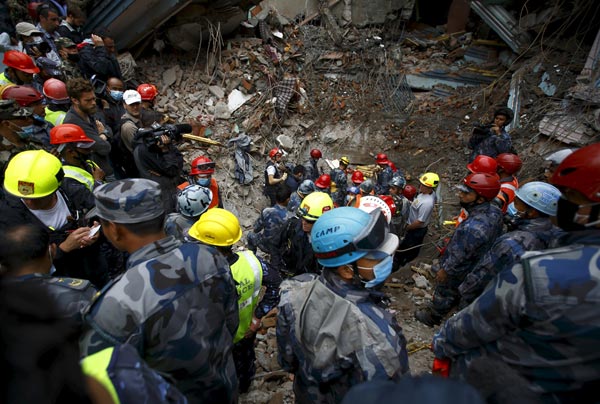
Members of the Nepalese Armed Police Force work at the ruins of the Hilton Hotel, the site where earthquake survivor Pema Lama, 15, was trapped in following an earthquake in Kathmandu, Nepal in this file photo. — Reuters photo
NEPAL (FRANCE24): Ceremonies were held last Sunday in Nepal in memory of the victims of the earthquake that devastated the Himalayan country a year ago. On April 25, 2015, Nepal was shaken to its core when a magnitude 7.8 earthquake struck high up in the Himalayas.
Around 9,000 people died and hundreds of thousands were left homeless. Thousands of homes and buildings across the country were toppled. One year later, our reporters went back to Nepal to see how the country is recovering.
As we walk through dusty Kathmandu, signs of the havoc wrecked by thepowerful earthquake are easy to find. The streets may have been cleared of debris, but in several parts of the city it is easy to come across piles of bricks where a house used to stand, or to find buildings with cracks and gaping holes.
The earthquake’s destruction is even more evident when you head to the countryside. In Sindhupalchowk District, two to three hours north-east of Kathmandu, makeshift shacks and tent houses are everywhere. Thousands of people still have no homes. Many have spent the harsh Himalayan winter in these flimsy shelters, with no warm clothes. They told us how they had given up on receiving the aid money promised to them by the government.
With the winter behind them, these people are now preparing for the onslaught of the monsoons, either out in the open, or in their ramshackle temporary homes.
It was the same story up in the mountains. Many of the areas we passed through had been spared the worst or the earthquake’s devastation, but for those who had lost their houses, reconstruction had only just begun, mostly with the help of foreign organisations. As we trekked for three days in north-eastern Nepal on the route to Everest, we became aware of another effect of the earthquake – a drop in tourism to Nepal. It’s the spring climbing season, and guides, hotel owners and porters all told us that, although the consequences are hard to quantify, there has been a distinct drop in the number of tourists this year.
To add to Nepal’s woes, life in the country was almost paralysed for about six months last year after the minority Madhesi community group blocked southern trade routes with India. The protest was triggered by the adoption of a new constitution in September 2015.
The landlocked country suffered from fuel, food and medicine shortages for months. Emergency aid needed for immediate reconstruction and rehabilitation could not get through either, affecting the most vulnerable. In November of last year, the UNICEF estimated that over three million children under the age of five were in danger of death and disease.
With much of the government’s attention devoted to calming the tensions along the southern border, the reconstruction process suffered a major setback.
Today, many Nepalese do not feel anger, but rather a sense of resignation. People are resigned to the fact that they will have to fend for themselves. Some fear they will never see any of the millions of dollars the international community donated to Nepal after the quake.
We met three survivors in three different parts of the country. They told us their stories, describing what they experienced a year ago and what their lives look like today. Their stories and the stories of other people we met along the way helped us understand just how challenging the rebuilding process will be for Nepal.
